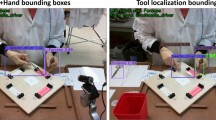Abstract
Background: This study examined perceptual-motor coordination with an apparatus that simulated a situation representative of endoscopic surgery.
Methods: Participants were trained with one arrangement of the apparatus, then tested with an alternative arrangement in which either the positions of the camera, the surgeon, or the objects in the surgical field were altered.
Results: Results showed that changes of either the camera's position or the surgeon's position disrupted performance. However, when the camera and surgeon positions were changed together, skilled performance was maintained.
Conclusions: This suggests that skill depends on a consistent mapping between the virtual hands and eyes, but not on the particular visual or motor orientations. The results suggest that movements of the camera during surgery can disrupt coordinated action. Also, in the design of training simulators, the mapping between camera and instruments may be more important than the static appearance of the displays or the topology of the movements.
Similar content being viewed by others
Author information
Authors and Affiliations
Additional information
Received: 27 February 1998/Accepted: 30 April 1998
Rights and permissions
About this article
Cite this article
Holden, J., Flach, J. & Donchin, Y. Perceptual-motor coordination in an endoscopic surgery simulation. Surg Endosc 13, 127–132 (1999). https://doi.org/10.1007/s004649900920
Published:
Issue Date:
DOI: https://doi.org/10.1007/s004649900920




